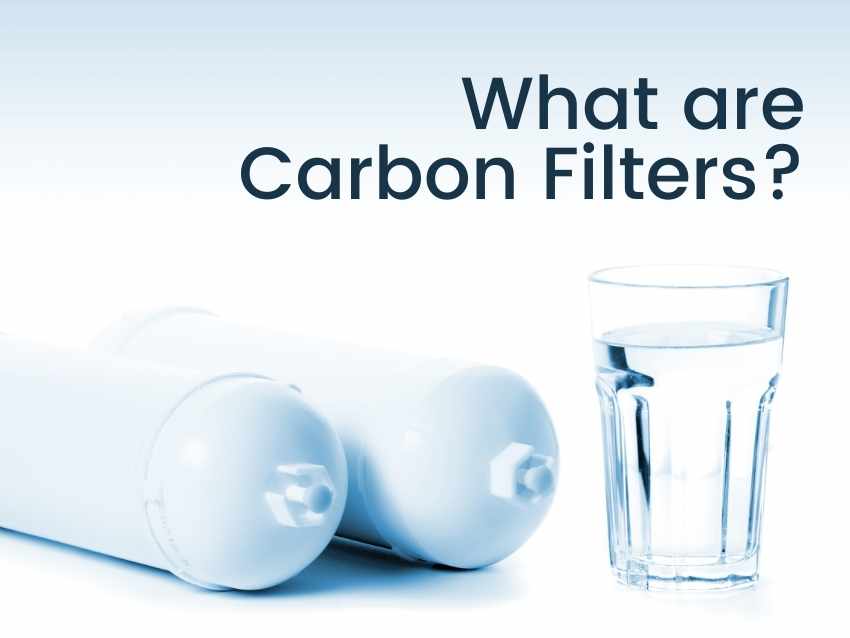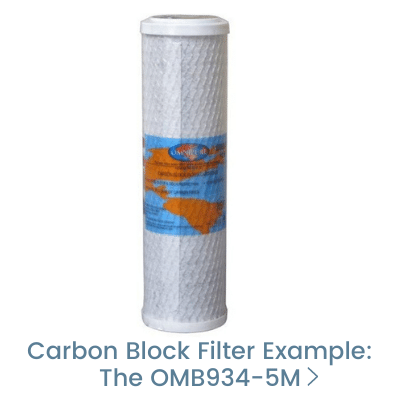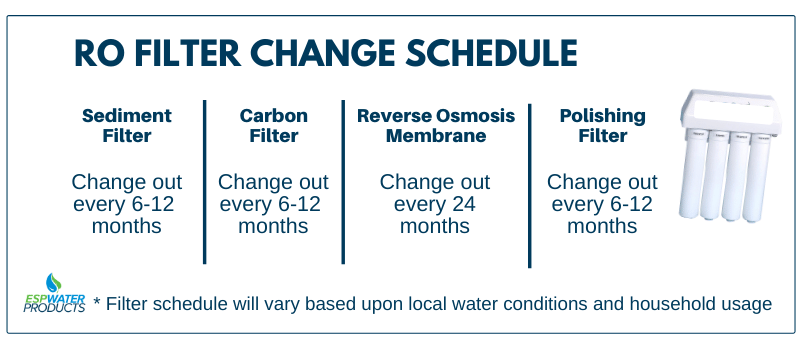What Do Charcoal Water Filters Remove
What are Carbon Filters?
 Carbon is a usually-used medium in water filtration processes. In fact, near every type of h2o filter system--whether it's a backpacking water filter, refrigerator filter, shower filter, pitcher filter, opposite osmosis water filtration organisation or whole-firm filter--utilizes carbon filtration in some way.
Carbon is a usually-used medium in water filtration processes. In fact, near every type of h2o filter system--whether it's a backpacking water filter, refrigerator filter, shower filter, pitcher filter, opposite osmosis water filtration organisation or whole-firm filter--utilizes carbon filtration in some way.
Carbon filters for h2o filtration are produced by grinding up a carbon source.
This carbon source could be:
- bituminous coal
- peat
- coconut shells
Of the above-mentioned carbon sources, kokosnoot shells are the most widely used and are highly renewable.
To create the filter, textile is heated in the absenteeism of oxygen to 1000 degrees to bake off impurities. The textile is then subjected to 1600-caste steam to "activate" the carbon. The steam leaves carbon granules filled with cracks and pores, enabling them to store large amounts of chemicals and contaminants.
How do Carbon Filters Work?

Carbon filters remove contaminants through adsorption. Adsorption ways that contaminants are attracted to the surface of the activated carbon and held to it, much the same way a magnet attracts and holds atomic number 26 filings.
Carbon filters also deed as a catalyst to modify the chemical limerick of some contaminants. Activated carbon is platonic for removing chlorine, organic chemicals such equally pesticides, THMs similar chloroform, and many VOCs that are components of gasoline, solvents and industrial cleaners.
What is a Granular Activated Carbon (GAC) Water Filter?
 GAC stands for "granular activated carbon" and is made of tiny, loosegranules of carbon. GAC filters are usually used as a "polishing filter' in the water filtration procedure and are highly effective at improving the taste and odor of drinking h2o.
GAC stands for "granular activated carbon" and is made of tiny, loosegranules of carbon. GAC filters are usually used as a "polishing filter' in the water filtration procedure and are highly effective at improving the taste and odor of drinking h2o.
While a GAC carbon filter is but loose pieces of carbon, a carbon block filter is where the loose pieces of carbon are compressed together to class a filter.
What practise GAC Water Filters Remove?
Granular activated carbon (otherwise known equally GAC) filters have extremely high adsorption capabilities and can remove a wide variety of contaminants (encounter contaminant listing here).
GAC filters are often used to remove VOCs, pesticides, nitrates, hydrogen sulfide, and much more.
Municipal water handling plants use disinfectants such as chlorine and chloramine which tin can go out an objectional gustation and odor in drinking water. GAC filters are able meliorate gustatory modality and scent, and are therefore commonly used as i or two stages in a opposite osmosis system.
What is a Carbon Block Filter?
A carbon block filter is where the loose pieces of carbon are compressed together to form a filter.
In a carbon block filter, one pound of compressed activated carbon (the amount in a standard ten-inch filter cartridge) has the equivalent expanse of a 160 acre farm, making it one of the near absorbent materials known to man.
Considering of the compressed nature of a carbon block filter, water flow rates are lower than that of a GAC filter made of loose medium. And menstruation rates are impacted by the micron rating of the filter. A carbon cake filter is rated to a certain micron rating depending on how much the carbon is compressed. The smaller the micron rating, the finer the filtration and the lower the catamenia rate.
Carbon Block Filters vs. GAC Carbon Filters
What is the difference between a carbon block filter and a GAC filter? Carbon block filters and GAC filters are made of the same cloth, merely one is fabricated of ground up loose carbon and the other is the loose carbon that has been compressed.
Many water filter systems use both carbon block AND GAC filters in the water filtration process.
Carbon block filters are made of a solid block of compressed carbon and are oft used equally a pre-filter in opposite osmosis and other water filtration systems. Carbon block water filters are extremely effective in filtering out a diversity of contaminants including very small-scale contaminants or particle size. H2o will generally menstruum slower during this filtration phase due to the meaty nature of the compressed carbon.
The granular activated carbon or GAC h2o filter is fabricated of loose carbon granules. Water flows more freely through this stage, and so menstruation rates are higher for GAC filters than carbon block filters. GAC filters also have very high adsorption properties and tin can remove contaminants including chlorine, hydrogen sulfide, lead and much more.
| |  | |||
| Filter | GAC (Granular Activated Carbon) | Carbon Cake | ||
| Medium Type | Loose carbon granules | Compressed carbon | ||
| Filtration Purpose | Prefilter & Polishing filter | Prefilter | ||
| Typical Use |
|
| ||
| General Flow Rates | Generally higher menstruum rates | Generally lower menses rates | ||
| How Oftentimes to Replace | Every six-12 months* | Every 6-12 months* | ||
| Advantages | May do a ameliorate chore at adsorbing certain contaminants | Can adsorb AND filter |
* Filter replacement schedule will vary based upon local h2o conditions and household usage
Carbon Block Filters are Rated in Microns
Carbon block filters are rated by the size of contaminants that can be removed at the micron level. Mostly, the range is from 50 microns down to .five microns. The college the rating, the larger the contaminant size. Very small contaminants will need to be filtered with a pocket-size micron size rated filter, such equally .5 micron rating.

How Often Should Carbon Water Filters Be Changed?
For carbon filters used in reverse osmosis drinking water systems, both the carbon filter and the polishing filter (granular activated carbon filter) should be replaced every vi-12 months. Ultimately, the lifespan of a carbon filter can vary based on how dirty or contaminated the h2o is. Carbon quality, humidity and usage can too factor into how long a carbon filter tin can last.

Are Carbon Filters Safe?
Yeah. In fact, many of the carbon filters we carry have been tested and rated by a 3rd party for material condom.
Do Charcoal H2o Filters Work?
Charcoal is a type of carbon that was used in the by, but rarely used at present. Typically all carbon filters are now made from coconut. Usually when someone refers to "charcoal filters", they actually mean carbon filters, and carbon filters are extremely effective in removing contaminants from water.
What are Coconut Water Filters?
Coconut water filters are made of coconut husk carbon that has been vacuum heated in a lab and cleaned. Coconut is the most common type of carbon used in h2o filters today as they are effective at removing bad tastes, odors, VOCs, chlorine, pesticides, and more.
What are Catalytic Carbon Filters?
Catalytic carbon filters are a type of carbon filter that contains a special catalytic carbon block. Catalytic carbon filters are highly constructive at chlorine and chloramine reduction. One example of a catalytic carbon filter is the Matrikx ChloraGuard water filter.
What Practise Carbon Filters Remove From Water?
Carbon filters tin effectively remove or reduce many contaminants from water including VOCs, chlorine, pb, fluoride, pesticides and much more. For a more comprehensive list, read What Practise Carbon Filters Remove.
What Do Charcoal Water Filters Remove,
Source: https://www.espwaterproducts.com/carbon-filters/
Posted by: quinnpase1945.blogspot.com



0 Response to "What Do Charcoal Water Filters Remove"
Post a Comment